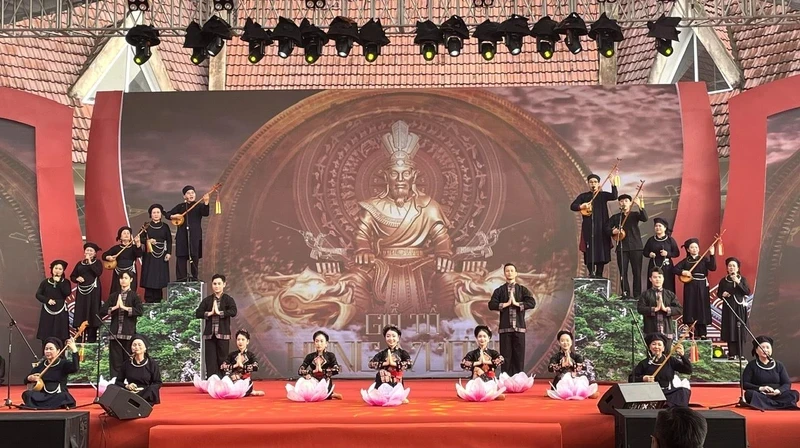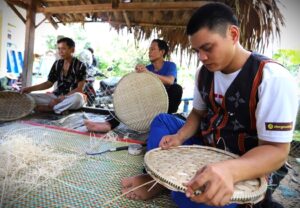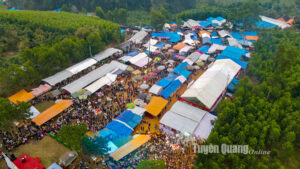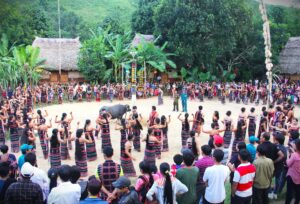Spreading ‘Then’ heritage value in community
The first Then singing and Tinh lute art festival of the Tay, Nung, and Thai ethnic groups has just been held at the Vietnam National Village for Ethnic Culture and Tourism in Hanoi.
 Artisans perform at the Then singing and Tinh lute festival of the Tay, Nung, and Thai ethnic groups in Hanoi in 2024. |
This is an opportunity for the people of the capital and tourists to learn about a unique folk performance of Then singing and Tinh lute in contemporary life, contributing to promoting the development of community tourism.
Then singing and Tinh lute are a type of folk performance of the Tay, Nung, and Thai ethnic groups in the mountainous regions of the Northwest and Northeast. Nowadays, along with the migration and settlement of people in new lands across the country, Then singing and Tinh lute have gone beyond the familiar practice space.
The participation of delegations from Dak Nong, Dak Lak, Lam Dong, and Hanoi at this festival is also a testament to the strong vitality of a unique heritage, contributing to spreading the unique cultural beauty and values of Then singing and Tinh lute art, and creating conditions for the community to participate in preserving and promoting the value of Then singing.
In 2019, Then singing practice of the Tay, Nung and Thai people in Vietnam was recognised by UNESCO as a representative intangible cultural heritage of humanity. Playing an important role in the lives of the Tay, Nung and Thai ethnic groups in the Northwest and Northeast, Then singing not only has religious values but is also a resource contributing to sustainable tourism development.
Currently, in many tourist areas, Then singing and Tinh lute have become attractive cultural tourism products, attracting the attention of tourists. In life, besides ancient ritual Then singing; Then singing for performance, known as “new Then singing”, has developed strongly with outstanding values in community tourism activities.
The movement of composing new lyrics based on old melodies has added new colours to Then melodies. Then singing is not only good in terms of melody but also in terms of language that suits modern musical tastes.
Many new Then lyrics have connected Then singing with more audiences, contributing to nurturing and promoting the value of Then singing in contemporary musical life.
Both types of Then singing have enriched the cultural and artistic treasures of the Tay, Nung, and Thai ethnic groups, creating a deep connection in the cultural life of the community. In Lang Son, Cao Bang, Bac Giang, Then singing heritage has developed strongly in the two types.
Currently, Lang Son Province has more than 500 Then singing practitioners, more than 60 Then singing-Tinh lute clubs with about 1,500 members, creating a widespread Then singing movement. Lang Son conducts active promotion, opens classes, and establishes clubs to preserve and develop Then heritage.
In Cao Bang, Then singing and Tinh lute are the pride of the people in the province. There are about 700 mass art clubs in the province, with Then singing as the core. Recently, Cao Bang has been maintaining the organisation of provincial level Then singing and Tinh lute festivals.
The Cao Bang Provincial Association for the Preservation of Ethnic Folk Songs pays great attention to activities, collecting, researching and preserving ethnic folk melodies with more than 2,000 members participating, creating a widespread Then singing movement.
Many artisans have opened classes to teach Then singing, passing on the value of heritage to the next generation. In the 2023-2024 school year alone, the Cao Bang Provincial Department of Culture, in coordination with the Department of Education and Training, has introduced Then singing into a pilot teaching programme at several schools, encouraging the younger generation to learn and love this type of folk song.
In Tuyen Quang, there are currently 70 Then singing and Tinh lute clubs with artisans as the core, promoting the Then singing movement, while actively collecting and preserving ancient Then melodies.
At community tourism sites in Thai Nguyen Province such as Thai Hai Tay Cultural Village and Ban Quyen Community Tourism Village, ATK Dinh Hoa Then Club has exploited Then singing as a cultural resource to attract tourists.
In Hanoi and Ho Chi Minh City, Then singing and Tinh lute clubs have been established with young people with a passion for preserving ethnic music as the core, thereby bringing Then heritage into tourism activities and opening a new direction for many localities in preserving and promoting Then values in cultural and artistic life.
Then singing has been and is being infused with strong vitality through integration into community tourism activities; regularly participating in festival programmes and political events of localities.
Then singing heritage is being strongly preserved and promoted, not only as a valuable cultural asset of the Tay, Nung, and Thai people but also having profound significance in spiritual life, playing an important role in sustainable tourism development in the Northeastern provinces.
Recently, in the workshop on the source and development of cultural tourism in the Northeastern region, many delegates shared the same opinion that if the policies for preserving Then singing and Tinh lute encourage the community to join hands in practicing, Then singing will promote its value worthy of its stature, becoming a unique cultural tourism product of the Northeastern region and contributing to creating economic value for the local community.
To effectively exploit the potential of Then singing heritage in tourism development, it is necessary to implement synchronous solutions such as strengthening the preservation of cultural spaces, developing new tourism products associated with Then; policies to protect cultural spaces, traditional architecture and ritual activities, community activities; Regularly organise exchanges, cooperation and connections so that the art of Then singing can be spread widely.
To preserve and promote the unique identity of the ritual Then singing, there should be policies to encourage and motivate artisans to teach Then to the younger generation as well as participate in community service.
For Then singing for performance, it is necessary to create a playground for artisans, artists and Then singing lovers to compose new Then songs, adapt ancient Then songs, and create works that are imbued with the breath of the times; encourage young people to participate in practicing and protecting Then singing; and increase promotion and bring Then singing closer to the public through social networking platforms such as YouTube, Facebook, and TikTok.
With the appropriate methods today, Then singing practice will always be protected and developed by local communities and cultural organisations.
NGOC LIEN
Translated by NDO
nhandan.vn




